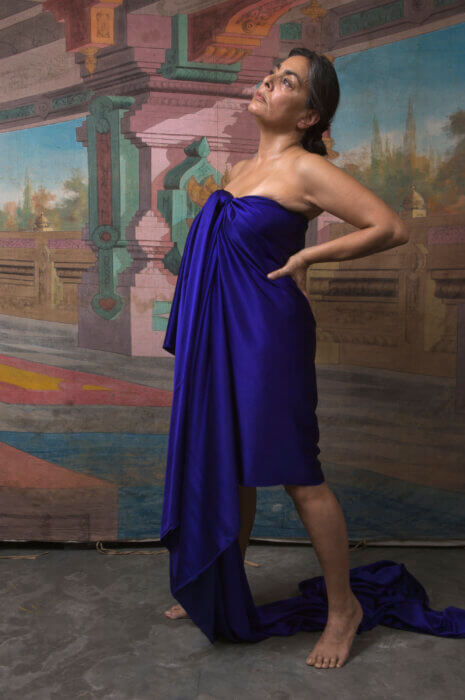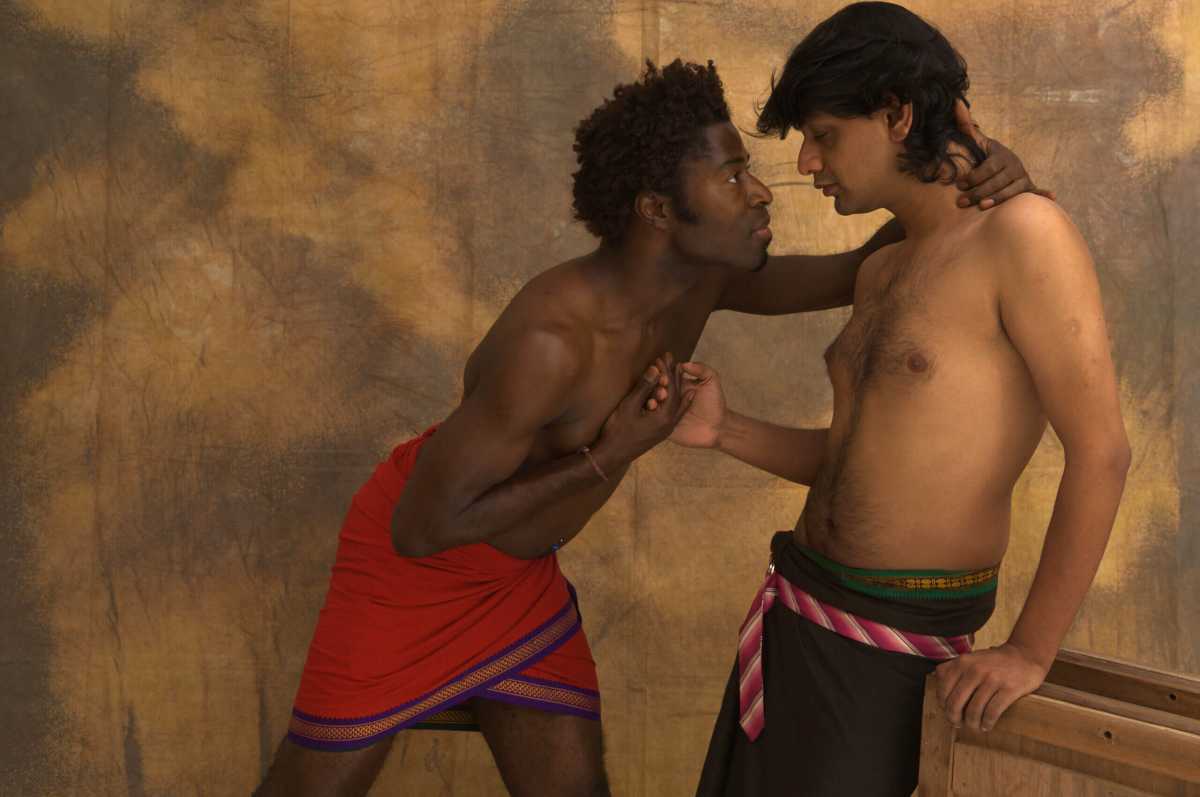From an aesthetic point of view, Sunil Gupta’s exhibition, “The New Pre-Raphaelites,” harkens back to a bygone era. Politically, however, it could not be more timely. Two days before the show opened, on Oct. 19 at Chelsea’s Hales Gallery, the Supreme Court of India handed down its decision to refuse to adjudicate the legalization of same-sex marriage, as Gay City News reported. The ruling was a major setback for the country’s LGBTQ movement, in whose support Gupta, back in 2008, produced the very portraits that comprise “The New Pre-Raphaelites” while residing in his native India.
The exhibition features 10 photographic portraits, each named “Untitled,” of singles or couples whose poses and backdrops are modeled on figures and scenes in paintings associated with the Pre-Raphaelites, a movement founded in 1848 in England to reform artistic convention. Works in the Pre-Raphaelite style are often luminous and set in nature. And while heavy in Christian symbolism, a number of them depict forbidden romantic trysts their creators experienced in real life. For instance, Dante Gabriel Rossetti’s painting, “Paolo and Francesca da Rimini” (1867), on which Gupta’s “Untitled #2” is based, both showing couples stealing kisses, is a story of adultery. Stylistic and biographical elements such as these were inspirational to Gupta when he set about creating a body of photographs in response to Section 377 of the Indian Penal Code, a 19th-century anti-sodomy law instituted by the British during colonialism. (In a landmark victory in 2018, Section 377 was ruled unconstitutional in regard to consenting adults, decriminalizing male homosexual acts in India.)

The subjects in “The New Pre-Raphaelites” were all campaigners and community members in that grassroots movement to decriminalize homosexuality. Some had romantic connections to one another. The subject of “Untitled #15” is the artist’s own life partner. The photograph is a recreation of the painting, “Broken Vows” (1856) by Philip Hermogenes Calderon wherein a woman stands with her back against a garden wall, eavesdropping in despair on a conversation between two people on the other side, a man handing a woman a flower. Whereas in Calderon’s composition the subject, her face distraught (she is overhearing her betrothed woo another person), is Victorian in dress, every inch of her body covered up, in Gupta’s photograph, the model wears a loose-fitting shirt without any pants, his crotch alluringly shadowed.
The painter John Everett Millais was a founding member and visionary of the Pre-Raphaelites, and Gupta gives homage to him in two pieces. The first, “Untitled #4,” is reminiscent of Millais’ “The Bridesmaid” (1851). In both Gupta’s and Millais’ piece, the subject is a woman with long, Rapunzel-like hair with flowers at her chest. The second, “Untitled #6,” is a restaging of Millais’ “Mariana” (1851): a woman in a richly-tinted blue dress, hands on her lower back, elongates her spine and neck. Perhaps it is the burdensome labor that cisgender women, themselves unendangered by the male-specific Section 377, contributed to the movement in solidarity with gay men and trans people, that Gupta is honoring here.
He undoubtedly pays tribute to the female Pre-Raphaelites, both creators and models, with “Untitled #11,” inspired by the painting “Fanny Eaton” (originally titled, “Head of a Mulatto Woman”) (1861) by Joanna Mary Boyce. The actual Fanny Eaton was a Jamaican-born woman who moved to London in the 1840s and became a sought-after model by the Pre-Raphaelites, in whose paintings and drawings she appears time and again. “Untitled #11” recasts the close-up portrait of Eaton by Boyce as a bearded young man, possibly wigged, sporting a brightly colored mask festooned with yellow and blue-green feathers.
Whether in India or the US Bible Belt, rates of suicide and self-harm among LGBTQ youth, are disproportionately high. Given the theme of “The New Pre-Raphaelites,” we are reminded of this fact by “Untitled #7,” which restages Henry Wallis’ painting, “Chatterton” (1856), a depiction of the 18th century English poet Thomas Chatterton’s suicide at age 17. The beautiful young corpse in “Untitled #7” could be a representation of all those who die by their own hand when the law of the land deems them unnatural and unworthy.
In “Untitled #5,” I find prescience of a different challenge to community welfare, one not in India, but England, where Gupta has lived since 1978. The piece, modeled on William Dyce’s “The Meeting of Jacob and Rachel” (1850), captures a moment between two male subjects, one Indian, one of African descent. The latter leans in to look up at his companion’s downcast face, pressing the other man’s hand to his own heart conciliatorily. The portrait feels like an entente-in-motion, and is significant in light of one recent incident in particular. A few weeks ago, tensions exploded in a highly multicultural London neighborhood after the video of a violent altercation between a South Asian shop owner and an Afro-Caribbean customer went viral. The incident, which led to street protests and a boycott, rekindled discussion about the tenuous state of relations between the two groups in Britain. Against this backdrop, “Untitled #5” is a compellingly multilayered reminder of historical solidarity between South Asian and Black communities in the United Kingdom, and the crucial role we queer folk can play to bridge racial divides. Gupta is a Millais of his time, as a founder of the Association of Black Photographers (later renamed Autograph ABP) in 1988 in London, a time and place in which British artists and activists (as well as many everyday people) of African, Asian, and Caribbean heritage moved in solidarity. “Untitled #5” offers hope that that time will come again.
Sunil Gupta, “The Pre-Raphaelites” | Hales Gallery | Until November 18, 2023
Nicholas Boston, Ph.D., is a professor of media sociology at Lehman College of the City University of New York (CUNY).



































